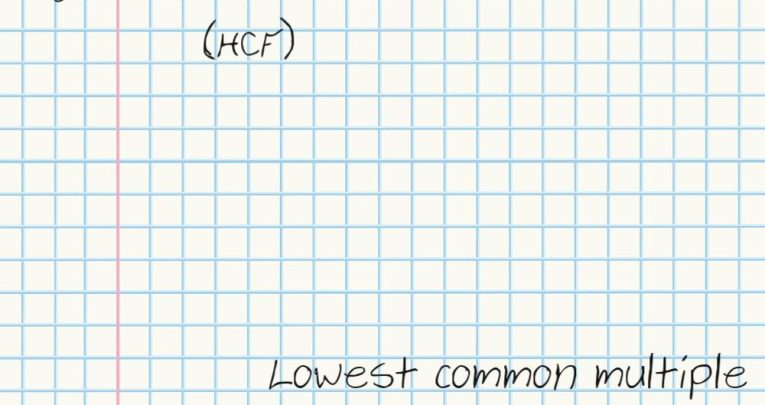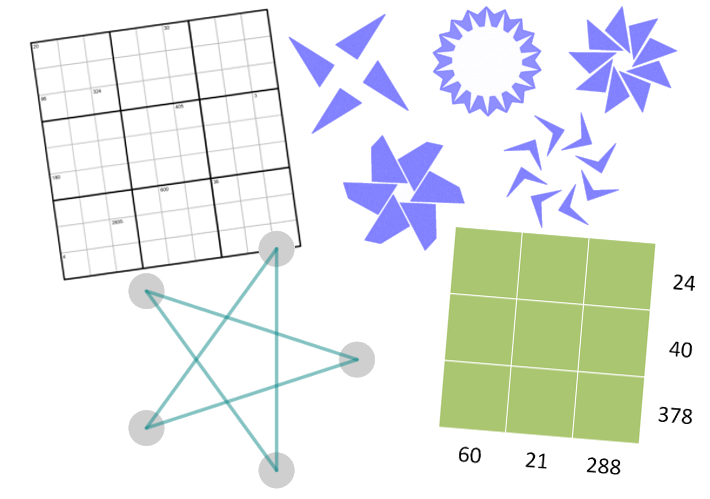5 of the Best KS3/4 Maths Resources and Lesson Plans for Teaching Lowest Common Multiple and Highest Common Factor

LCM and HCF are areas students often confuse, so these resources will help you make sure they know their factors from their multiples and offer some engaging activities to let the lessons sink in

- by Teachwire
- Classroom expertise and free resources for teachers

5 | The two essential stages of teaching HCF
This blog from Russell Timmins looks at Highest Common Factors (or Greatest Common Divisors) of two or more numbers, and states that there are two stages worthy of consideration when teaching HCF:
- Common factors and Highest Common Factors by inspection of 2 or more numbers
- Calculating by using prime factors
Check out this helpful article here.
Check out these activities and accompanying teaching notes here.
4 | Ensure students don’t mix up their factors and multiples in their GCSE
‘Lowest common multiple’ and ‘highest common factor’ – two vital skills for pupils to ‘master’. The problem is, however, that LCM and HCF is one of those mixed muddles often referred to in Chief Examiners reports, thanks to students showing confusion between “factor” and “multiple”.
Being able to use both terms forms the basis of skills such as adding and subtracting fractions which, funnily enough, is also an area commonly answered badly in final assessments.
So why are these two terms so obtuse (again, no geometric pun intended)? Is it because they are two acronyms used together? Could a better approach be to keep them acres apart in a scheme of work? Is it because times tables knowledge is sadly lacking? Should we be encouraging copious amounts of fluency work so that they eventually ‘get it’?
In this article Julia Smith explores ways you can help pupils wrap their heads around this commonly confused area of the KS4 curriculum.
5 | The two essential stages of teaching HCF
This blog from Russell Timmins looks at Highest Common Factors (or Greatest Common Divisors) of two or more numbers, and states that there are two stages worthy of consideration when teaching HCF:
- Common factors and Highest Common Factors by inspection of 2 or more numbers
- Calculating by using prime factors
Check out this helpful article here.
Check out this article from Lucy Rycroft-Smith here.
3 | Four NRICH activities
In this article, the NRICH team share four of their favourite activities for developing a greater understanding of HCFs and LCMs. Each activity encourages your students to work mathematically, justifying their solutions and considering alternative approaches to problems.
Getting started on a problem is often a challenge itself. At NRICH we find that students who get stuck often find it helpful to explore other students’ starting points then continue that solution, so we aim to feature student solutions to all of our problems on the website.
Check out these activities and accompanying teaching notes here.
4 | Ensure students don’t mix up their factors and multiples in their GCSE
‘Lowest common multiple’ and ‘highest common factor’ – two vital skills for pupils to ‘master’. The problem is, however, that LCM and HCF is one of those mixed muddles often referred to in Chief Examiners reports, thanks to students showing confusion between “factor” and “multiple”.
Being able to use both terms forms the basis of skills such as adding and subtracting fractions which, funnily enough, is also an area commonly answered badly in final assessments.
So why are these two terms so obtuse (again, no geometric pun intended)? Is it because they are two acronyms used together? Could a better approach be to keep them acres apart in a scheme of work? Is it because times tables knowledge is sadly lacking? Should we be encouraging copious amounts of fluency work so that they eventually ‘get it’?
In this article Julia Smith explores ways you can help pupils wrap their heads around this commonly confused area of the KS4 curriculum.
5 | The two essential stages of teaching HCF
This blog from Russell Timmins looks at Highest Common Factors (or Greatest Common Divisors) of two or more numbers, and states that there are two stages worthy of consideration when teaching HCF:
- Common factors and Highest Common Factors by inspection of 2 or more numbers
- Calculating by using prime factors
Check out this helpful article here.
Get this Colin Foster KS4 lesson plan here.
2 | Creative Ways to Teach LCM and HCF
The topics of factors and multiples – leading from earlier work on understanding multiplication and division, partitioning, making systematic lists and arranging items in different ways – can sometimes feel a little stale to teach.
Once we start talking about highest common factor and lowest common multiples and referring to them using their familiar acronyms (HCF/LCM), you might feel as if there is no innovation to be had in this area at all.
So here are some ideas that you can use over a series of lessons, and over a flexible time period, that suits the needs of your particular class.
Check out this article from Lucy Rycroft-Smith here.
3 | Four NRICH activities
In this article, the NRICH team share four of their favourite activities for developing a greater understanding of HCFs and LCMs. Each activity encourages your students to work mathematically, justifying their solutions and considering alternative approaches to problems.
Getting started on a problem is often a challenge itself. At NRICH we find that students who get stuck often find it helpful to explore other students’ starting points then continue that solution, so we aim to feature student solutions to all of our problems on the website.
Check out these activities and accompanying teaching notes here.
4 | Ensure students don’t mix up their factors and multiples in their GCSE
‘Lowest common multiple’ and ‘highest common factor’ – two vital skills for pupils to ‘master’. The problem is, however, that LCM and HCF is one of those mixed muddles often referred to in Chief Examiners reports, thanks to students showing confusion between “factor” and “multiple”.
Being able to use both terms forms the basis of skills such as adding and subtracting fractions which, funnily enough, is also an area commonly answered badly in final assessments.
So why are these two terms so obtuse (again, no geometric pun intended)? Is it because they are two acronyms used together? Could a better approach be to keep them acres apart in a scheme of work? Is it because times tables knowledge is sadly lacking? Should we be encouraging copious amounts of fluency work so that they eventually ‘get it’?
In this article Julia Smith explores ways you can help pupils wrap their heads around this commonly confused area of the KS4 curriculum.
5 | The two essential stages of teaching HCF
This blog from Russell Timmins looks at Highest Common Factors (or Greatest Common Divisors) of two or more numbers, and states that there are two stages worthy of consideration when teaching HCF:
- Common factors and Highest Common Factors by inspection of 2 or more numbers
- Calculating by using prime factors
Check out this helpful article here.
1 | Teach LCM and HCF together
‘The What Factor?’ takes the ideas of highest common factor and lowest common multiple, which are often taught separately, and deals with them together to help learners to appreciate the connections between them.
Get this Colin Foster KS4 lesson plan here.
2 | Creative Ways to Teach LCM and HCF
The topics of factors and multiples – leading from earlier work on understanding multiplication and division, partitioning, making systematic lists and arranging items in different ways – can sometimes feel a little stale to teach.
Once we start talking about highest common factor and lowest common multiples and referring to them using their familiar acronyms (HCF/LCM), you might feel as if there is no innovation to be had in this area at all.
So here are some ideas that you can use over a series of lessons, and over a flexible time period, that suits the needs of your particular class.
Check out this article from Lucy Rycroft-Smith here.
3 | Four NRICH activities
In this article, the NRICH team share four of their favourite activities for developing a greater understanding of HCFs and LCMs. Each activity encourages your students to work mathematically, justifying their solutions and considering alternative approaches to problems.
Getting started on a problem is often a challenge itself. At NRICH we find that students who get stuck often find it helpful to explore other students’ starting points then continue that solution, so we aim to feature student solutions to all of our problems on the website.
Check out these activities and accompanying teaching notes here.
4 | Ensure students don’t mix up their factors and multiples in their GCSE
‘Lowest common multiple’ and ‘highest common factor’ – two vital skills for pupils to ‘master’. The problem is, however, that LCM and HCF is one of those mixed muddles often referred to in Chief Examiners reports, thanks to students showing confusion between “factor” and “multiple”.
Being able to use both terms forms the basis of skills such as adding and subtracting fractions which, funnily enough, is also an area commonly answered badly in final assessments.
So why are these two terms so obtuse (again, no geometric pun intended)? Is it because they are two acronyms used together? Could a better approach be to keep them acres apart in a scheme of work? Is it because times tables knowledge is sadly lacking? Should we be encouraging copious amounts of fluency work so that they eventually ‘get it’?
In this article Julia Smith explores ways you can help pupils wrap their heads around this commonly confused area of the KS4 curriculum.
5 | The two essential stages of teaching HCF
This blog from Russell Timmins looks at Highest Common Factors (or Greatest Common Divisors) of two or more numbers, and states that there are two stages worthy of consideration when teaching HCF:
- Common factors and Highest Common Factors by inspection of 2 or more numbers
- Calculating by using prime factors















